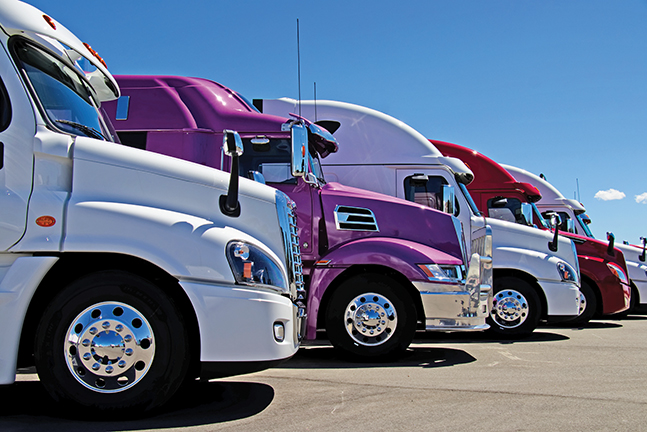Whether you’re taking the first steps toward owning your own trucking business or you’re a seasoned owner-operator, at some point you’ll have to consider investing in a truck. The options can be overwhelming. New or used? Comfort or efficiency? Power or fuel mileage? Before you set foot in a dealership or dial a single phone number, you should have a solid idea of what you’re looking for.
Before you make a truck-buying decision, it helps to understand that the truck you choose is — or should be — a business investment. There’s nothing wrong with choosing options that provide looks, comfort and other benefits, but there are almost always tradeoffs in fuel cost, maneuverability, freight capacity and more.
One of the first decisions you’ll make is whether you should buy a new truck or a used one. Some buyers look at the prices for new equipment and shy away, but there’s more to consider than just sticker price. Financing terms are often more favorable for new trucks than used. Interest rates are often better, especially if the manufacturer is running a special promotion. Down payments may be lower, and the loan length may be longer. Buyers also often find that the monthly payment is smaller.
Financing for used trucks is sometimes easier to qualify for, especially if your credit rating is less than stellar. Used truck dealers often have multiple financing sources and can shop for the best deal, but be careful. Higher-risk loans often come with higher interest rates, driving your monthly payment up.
Warranties can be a huge factor. New trucks usually come with a standard warranty that covers almost everything, plus a powertrain warranty that covers the drivetrain. Most manufacturers offer choices in extended warranties that cover more, and for longer periods, but you’ll pay extra for these — unless you’re able to negotiate with the dealer to cover the cost. Some truck brands have affiliated finance companies. Trucks financed through PACCAR Finance, for example, can qualify for an additional two years/200,000-mile extended warranty.
Many used truck dealers offer warranties, too, but they’re generally for shorter periods. For example, Arrow Truck Sales offers a 90-day/25,000-mile standard warranty on many of the trucks they sell. Ryder offers a 30-day limited powertrain warranty. Many dealerships offer third-party warranties from outside the manufacturer. National Truck Protection (NTP), for example, offers several choices of warranty protection that can be arranged through a dealer or by dealing directly with NTP.
Some used trucks are still covered under the original warranty. If so, make sure it’s transferable to a new owner before you close the deal.
One newer type of coverage being offered for both new and used trucks is the “aftertreatment warranty.” These plans cover the emissions systems mandated by the Environmental Protection Agency over the past 15 years, including particulate filters, selective catalytic reduction systems, DEF systems and more.
Don’t forget the hidden cost of warranty work. While your truck is in the shop, you can’t use it to haul freight. A “free” repair that results in your truck being down for a week results in a loss of revenue that can easily total thousands of dollars. Add your expenses for hotel rooms, food and possibly transportation to and from the shop. The older the truck, the more days it is likely to spend in the shop per year. Large carriers usually follow a trade cycle that ensures trucks are replaced before maintenance costs get out of hand.
Many drivers are choosy about the powertrain in the truck they choose. Many new truck models come standard with 13-liter diesel engines and automatic transmissions. While this combination maximizes fuel efficiency and increases cargo capacity due to lower weight, it hasn’t been a hit with independent owners. Many drivers prefer the tried-and-true 15-liter engine for the additional power it provides. Some also prefer the control a manual transmission provides, and many still like or need the gear-splitting options provided by 13- and 18-speed manual transmissions.
Most new trucks offer a variety of options including sleeper size, seats for both driver and passenger, bumpers, wheels, and different trim packages. One adage holds true: Upgrades drive up the cost. Trim packages can include decorative panels, upgraded materials, better stereo systems and others. Options can be selected when a truck is ordered, but often a buyer is stuck with choosing a unit that’s already in stock.
Used trucks, on the other hand, usually come as they are equipped. There is less choice, but often the options that drove up the price when the truck was new don’t add nearly as much value to a used truck.
Advanced driver-assistance systems (ADAS) provide safety features such as collision mitigation, lane-departure warnings and blind-spot monitoring. Newer trucks are more likely to be equipped with these systems, but late-model used trucks can have them too.
Finally, timing is important when deciding what to purchase — or whether to purchase at all. Orders for new trucks have greatly outpaced the production capability of the major OEMs, resulting in a waiting list of six months or more. New trucks can still be found on some dealer lots but options may be limited and prices aren’t likely to be discounted.
Used trucks are, on the average, priced lower than they were a year ago. Good deals can still be found. As the big carriers replace their equipment with new stock, more used trucks enter the market. As with used cars, there are reputable and disreputable dealers. Some dealers have national networks and support their customers after the sale while others offer minimal, if any, support if a problem arises. Research the dealer and carefully read anything you are asked to sign.
Remember that dealers aren’t the only places to find used trucks. Companies that lease trucks, such as Penske and Ryder, sell trucks that have been turned in after lease and can help with financing. More than a few carriers sell their used trucks outright rather than accepting trade-in prices. Buying from a private owner is another option, but keep in mind that financing and warranty options aren’t likely to be offered.
Buying a truck is a big step, and it could be the largest investment of your life. Understand the needs of your business first and then research until you find the right truck for your needs.
Cliff Abbott is an experienced commercial vehicle driver and owner-operator who still holds a CDL in his home state of Alabama. In nearly 40 years in trucking, he’s been an instructor and trainer and has managed safety and recruiting operations for several carriers. Having never lost his love of the road, Cliff has written a book and hundreds of songs and has been writing for The Trucker for more than a decade.









wow! that’s a completely amazing post, really like information and suggestion in the post but running Semi-Trailer and Truck business hassle-free we must have Trucking software, which makes this business smooth and less hectic,
I really want to thank the author for this article.
I appreciate your article explaining the different aspects of purchasing a truck used rather than new. I agree with you that it would be very important to research potential dealers to make sure they are relaible. I’d imagine that a good way to do so would be by checking online reviews from their past customers. http://usedtruckdealer.com/inventory/freightliner-trucks-for-sale/?&manufacturer[]=freightliner&listing_order=price&listing_orderby=DESC
It’s good to know that it’s important to research the dealer before buying a used commercial vehicle. I think that would help make sure that you could get a good deal on a truck and that you could also be safer and do your work properly. Thanks for detailing what to consider when buying a commercial truck. http://www.arrowtruck.com/
You made a good point when you mentioned that financing is easier to obtain for used semi-trucks. It could be a good idea to have a mechanic inspect the truck for you before you purchase. I would imagine that a semi-truck specialist would be able to spot things you missed. https://www.southsidefleet.com.au/on-site-servicing
Thanks for mentioning that even used truck facilities offer warranties. I’m hoping to purchase a new utility truck for my business this year. I don’t need one that’s brand new, so it would be good if I could find a used truck in decent condition. http://pacifictruckequipment.com/bodies